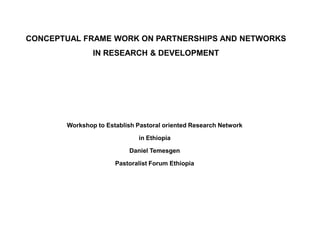
Ethiopian Pastoral Research and Devlopment network by daniel temesgen
- 1. CONCEPTUAL FRAME WORK ON PARTNERSHIPS AND NETWORKS IN RESEARCH & DEVELOPMENT Workshop to Establish Pastoral oriented Research Network in Ethiopia Daniel Temesgen Pastoralist Forum Ethiopia
- 2. Introduction This presentation is based on a review of literature on inter-organizational partnerships With the following purposes: a) Highlight the current thinking on partnerships and networks b) Reviews key concepts and approaches of partnership
- 3. Background Over the last decades there has been an increase in the use of new forms of organization in both the public the private sector and CSOs Traditional forms institutional arrangements are giving way to new ways of linking institutions and their activities This growth in cooperative arrangements is a global phenomenon, fueled by advances in information technology, and globalization pressures The rate of alliance formation has been growing at an annual rate of more than 25% It has become increasingly clear that relying only on one’s own resources and skills would not let an organization go far.
- 4. Background The shift towards increased reliance on partnerships is most visible in development research Today, most of the research programs are linked in numerous ways with collaborators in dozens of countries In recent estimate the number of partnerships the 16 CGIAR centers was found to be 2,000
- 5. The Trend towards Research & development Networking Research networks are becoming important features of the research environment for the following reasons : to overcome the common obstacles of Limited public resources to support research To Coordination problems stemming from the dispersed organizational and geographic locations of researchers, and difficulties in designing frameworks to connect the capabilities of researchers (Portes and Yeo 2004, DEST 2004, O’Toole 1997).
- 6. To establish a more responsive innovation systems To ensures efficient linkage collaboration among actors To enable actors adapt and respond to new requirements, changing circumstances and challenges
- 7. Advantages of Research & development Networks In principle, research networks offer a number of advantages It help share filter information and ideas Bring together the expertise (scholars) at national and international research environment frequently characterized by fragmentation and isolation Research networks facilitate actual cooperative research among actors that otherwise would not occur Enable participating scholars to be more productive in their research endeavors
- 8. Terminologies/theoretical frameworks Review of the recent literature on partnerships and networks reveals that: (1) there is no uniformity in the terminology used; and (2) there is no single dominant theoretical framework The three most widely used terms are alliances, networks, and partnerships. Other terms used to define similar relationships include cooperation, collaboration, and coalition. One common characteristic of these terms is that they all refer to inter-institutional relationships.
- 9. Networks A network is a “multi-partner cooperative arrangement between more than one organization” A few definitions from the literature : Networks constitute the basic social form that permits inter- organizational interactions of exchange, intensive and, joint action Networks are clusters of organizations, are non-hierarchical collectives of separate units Networking is the art of creating and/or maintaining a cluster of organizations for the purpose of exchanging, acting among the member organizations (Alter and Hage, 1993).
- 10. Therefore • Networking is an act of linking /integrating/ individuals, organizations and institutions to promote mutual learning and generate, share, transfer and utilize technologies, knowledge, information and innovations
- 11. Partnerships A partnership is a long-term cooperative arrangement between two or more institutions involving exchange or sharing of resources to attain a common objective. Aspects of this definition: The focus of attention is on inter-institutional relationship long-term Cooperative arrangements The minimum number of partners is two, but there is no upper limit on the number of institutions that belong to a partnership Exchange or sharing of resources
- 12. Partnership Types Partnerships vary in terms of several variables--for example: size (e.g. number of partners), geographical scope of activities (e.g., local, national, international),type of partner (e.g., private sector, public sector, public-private, GO_NGO) As a rough categorization of partnerships that apply to the research Research partnerships (these involve cooperative arrangements with other institutions for conducting joint research) Exchange partnerships (these involve formal arrangements for exchanging information, materials, staff, intellectual property, etc., with other institutions) Service partnerships (these involve providing services to a partner institution, e.g., training, consultancy, capacity building, as part of a long-term relationship – not as a market-based)
- 13. Networking & Partnership Formation Why ? Entering in to Partnership & networking are strategic decisions organizations make in order to fulfill their mission. These include the following: Mobilizing resources. helps mobilize additional resources and enhance the potential of the organization’s own resources to generate impact. ( Information, material, capital, technology and management) Competencies. facilitate Pooling complementary knowledge and skills and learning . Increasing the scale of activities. lowering average costs and increase outputs by exploiting the synergy generated by relying on the comparative advantage of each partner
- 14. Points to consider for successful partnership & networking Common objectives & interests among partners Existence of clear agenda and objective/vision Trust between partners Commitment to common goal Clear MOU between partners Clearly defined roles and responsibilities among the partner Respect for all opinions Exchange knowledge/experiences Good communication
- 15. Empirical studies indicated that : for successful networking & partnership Commitment (of partners to the partnership) Coordination (of activities) Trust Quality of communication (accuracy, timeliness, adequacy Participation (joint planning and goal setting) Joint problem solving